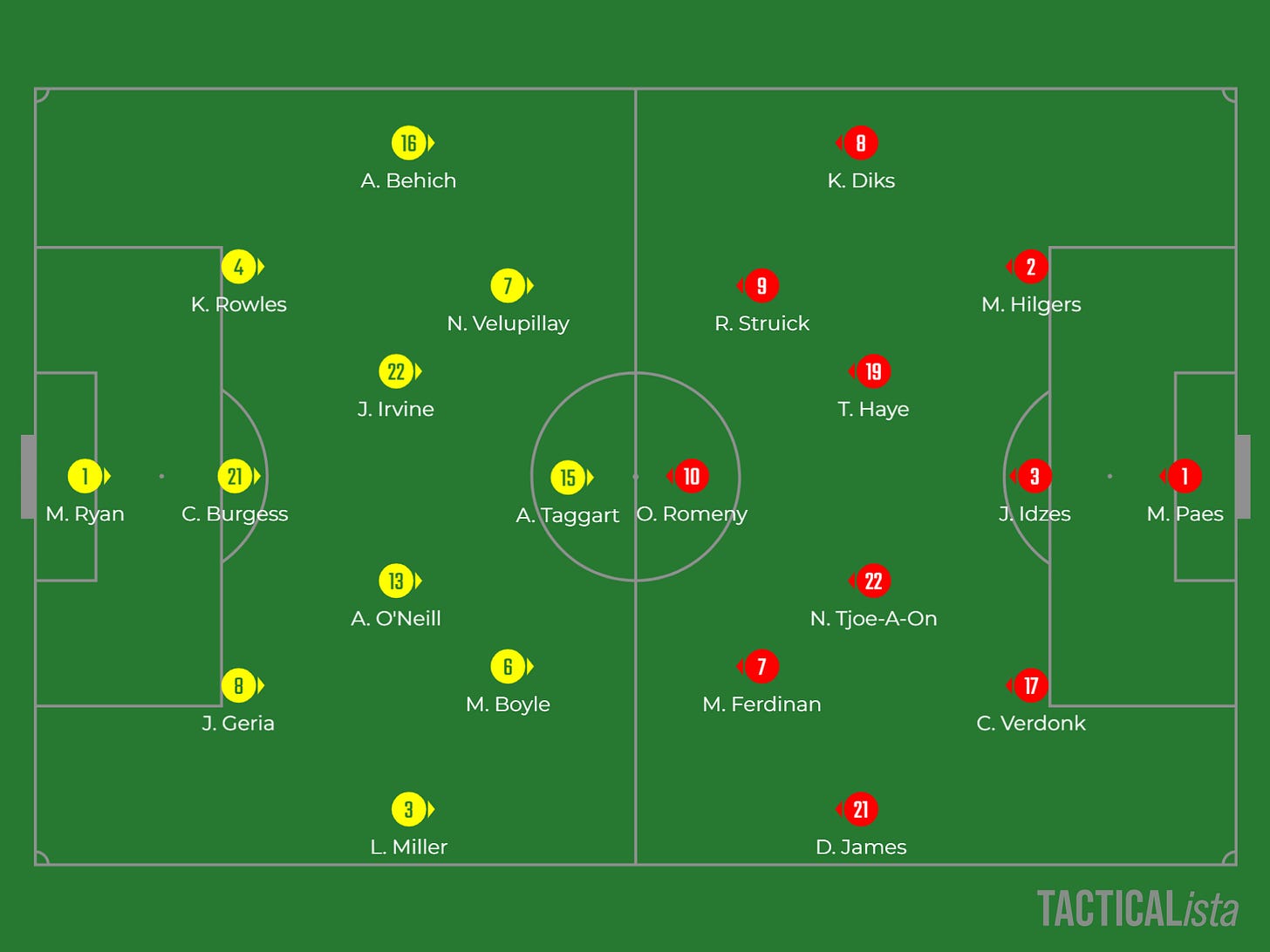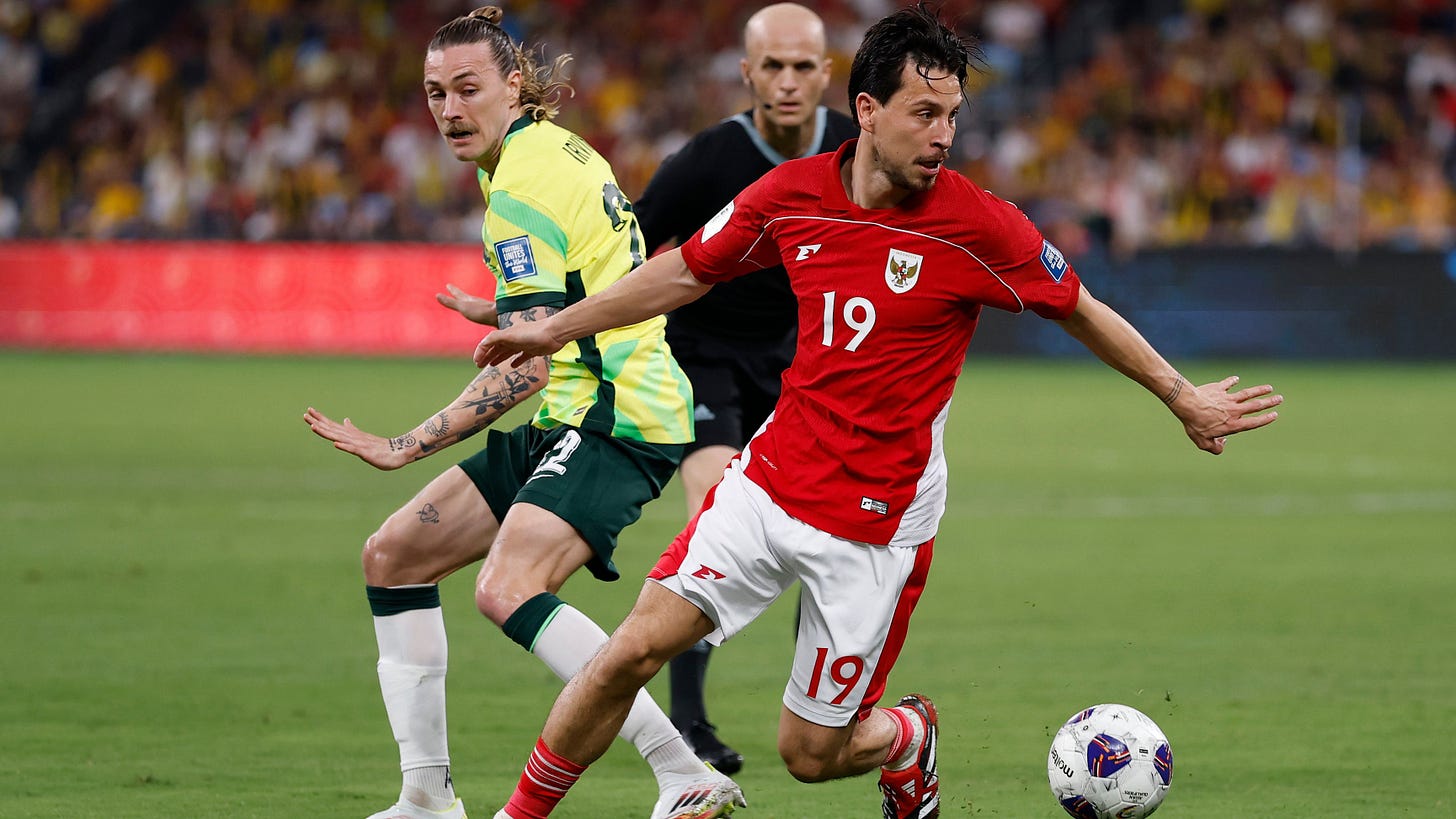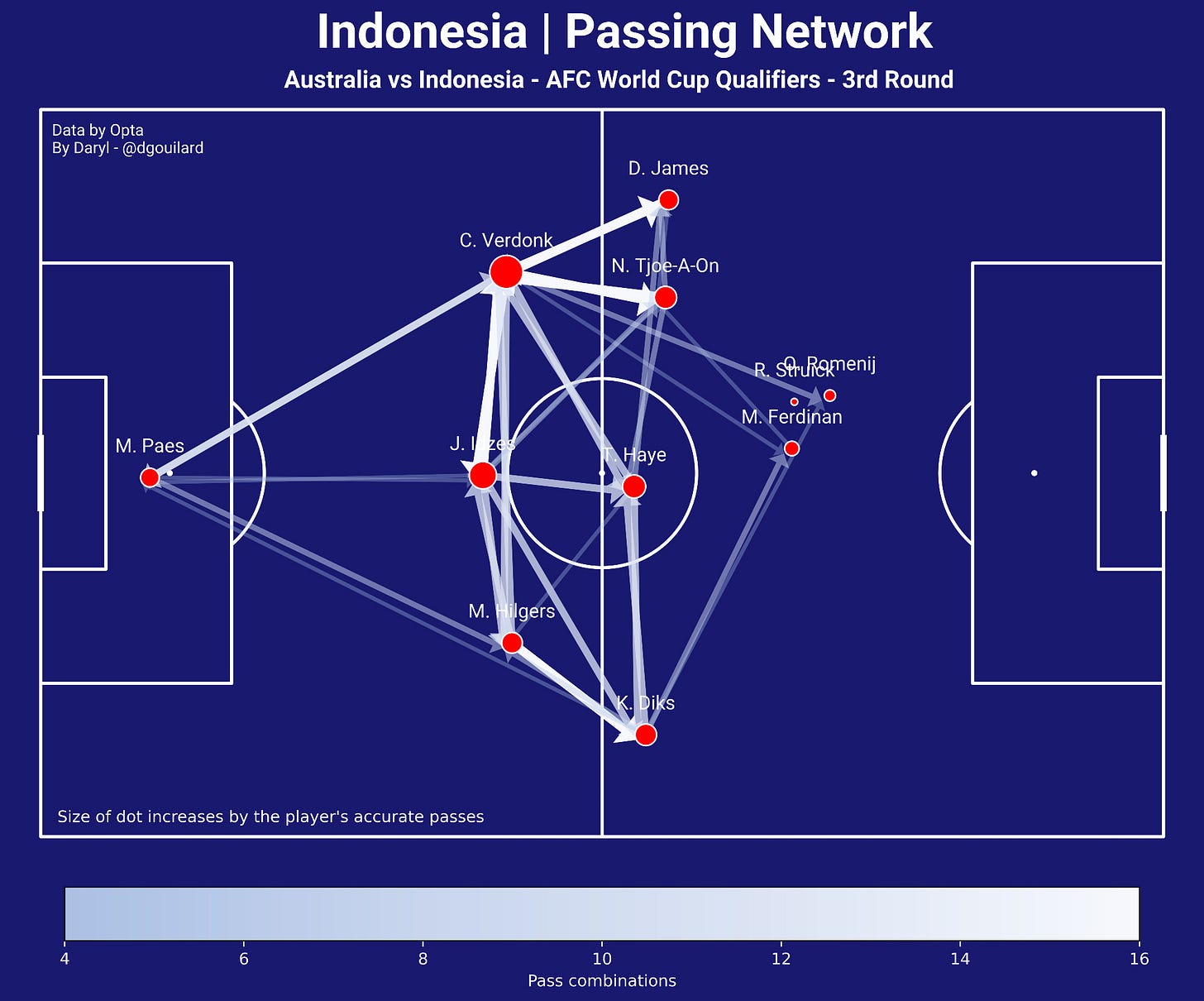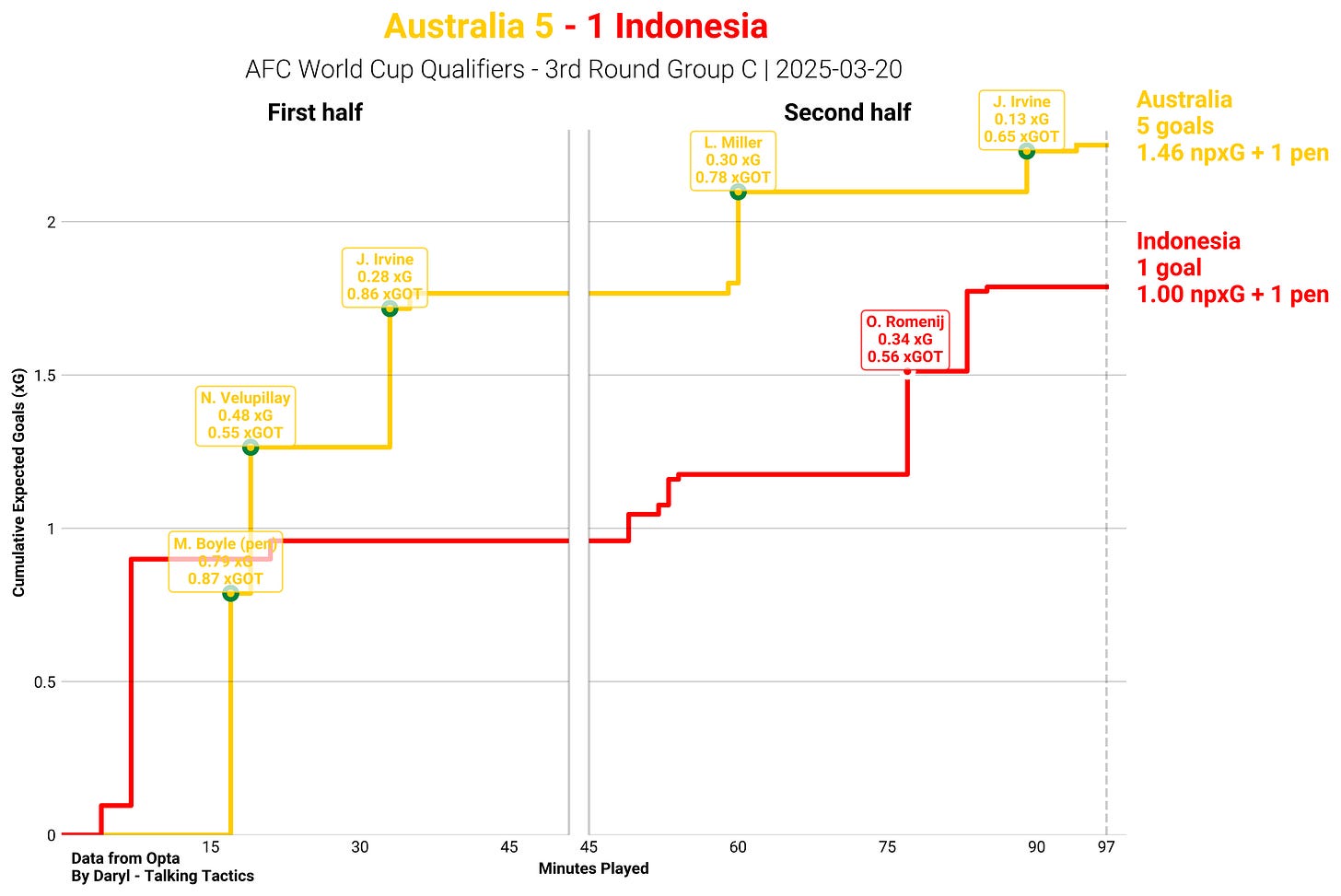Daryl's Notebook: Quick thoughts from Australia vs Indonesia
In a fairly equal group C of the Asian Qualifiers, anything matters. Here, a rivalry could also be born.
It is crazy to think that, besides from Japan who has obviously clinched the top spot of Asian Qualifiers group C and the first spot to North America in 2026, every team in the group are still in with a chance to either take the remaining automatic spot or qualify for the fourth qualifying round. Australia were taking pole position in second place with a point over the rest of the group as they welcomed a fired-up Indonesia side who were looking to make history with a mostly naturalised group of players.
Reporting (not) live from Sydney and after a rewatch of the match, I had a lot of thoughts regarding the match. So, why not mark the return of the Notebook after a long break with some thoughts about the Socceroos vs Team Garuda match?
Lineups

The Socceroos’ lineup did not surprise me much considering this was an important match for the home side. As such, it was understandable that Tony Popovic went with his strongest lineup in a 3-4-2-1 formation and stuck to his preferred style. The decision to use (#15) Adam Taggart up top baffled me at first since he is currently nowhere near one of the best strikers in the A-League, but knowing that (#9) Kusini Yengi just returned from injury for Ipswich Town, and he might not be fit enough to start right away, I understood the decision to start Taggart.
Indonesia’s lineup also did not surprise me, but it was interesting to see what Patrick Kluivert would bring to the team since his style is significantly different compared to his predecessor’s, Shin Tae-yong, style. A couple of debutants caught my attention, including left wing-back (#21) Dean James from Go Ahead Eagles and striker (#10) Ole Romeny, who I was super excited to see since he brings a completely different striker profile to Indonesia, and it also meant that they did not have to rely on (#9) Rafael Struick, (#7) Marselino Ferdinan, and the suspended Ragnar Oratmangoen for goals.
There were a few names from both teams that I would have loved to see, but did not get the chance to play or even made the bench. For Australia, it was the trio (#17) Kai Trewin, (#20) Ryan Teague, and Nectar Triantis. While Trewin and Teague have enjoyed a very solid season in the A-League for the two Melbourne-based clubs respectively, Triantis has been something of a revelation for Hibernian after he was converted from a centre-back to a defensive midfielder. For Indonesia, I was looking forward to see (#12) Emil Audero and (#14) Joey Pelupessy, who were two other players looking for their debut cap in this window.
A complete contrast
Since the last time both teams faced each other back in September of last year, Indonesia have made a significant change on the sideline as Patrick Kluivert was appointed as head coach and replaced Shin Tae-yong at least for the remainder of the 2026 World Cup qualifiers. Without going deep into whether the appointment makes sense for Indonesia or not, Kluivert brings a different playing style to Team Garuda and it is expected to be a Barcelona/Ajax-influenced, possession-oriented style.
A quick look at the stats will tell you that Kluivert did try to implement such style right away in his first match. In total, Indonesia controlled 60% of possession and made a total of 520 passes, and their possession percentage never dropped below 50% throughout the match. But as the score suggests, that…did not work out too well for the Southeast Asian side. This is probably a good time to look at Indonesia’s passing network and attempt to decode why having a lot of possession did not help them.
The first thing that jumped out right away is the high volume of passes between the defenders and midfielders. That is usually one of the signs that suggests something did not go well here. When a team have to circulate the ball at the back for most of the time, that means they are unable to progress the ball forward and they get stuck with moving the ball side to side in the middle third of the pitch. That seems to be what Indonesia’s passing network is trying to highlight, and that was what happened during the match as well.
Whenever Indonesia had the ball, they seemed to find it tough to break Australia’s 5-2-2-1 mid-block down since the centre-backs and midfielders could not find a way to play through and reach the attackers up front. This resulted in a reliance on passing out to both wings for the wing-backs, where…Indonesia still found themselves blocked from getting the ball into the final third.
The fact that James did not have a single connection with the front three and (#8) Kevin Diks only had a faint connection with Romeny and Marselino on the passing network means that even the wing-backs could not find the attackers up front. Then, you would expect that the double pivot (#19) Thom Haye and (#22) Nathan Tjoe-A-On would be the ones who could connect the backline to the front three, but even they had a tough time and Haye could not even find the front three more than 4 times. The only player who was actually good at progressing the ball for Indonesia was left centre-back (#17) Calvin Verdonk.
Diverting away from the data and let’s get into the clips!
I will not take away credits for the Socceroos for how good they were with their mid-block and their attempts at blocking passing lanes from Indonesia’s centre-backs. But one of the biggest problems that Kluivert’s team showed when they had the ball was they were very static in possession. When you are going up against a mid-block, it is important to be active and make runs often, even if those runs are just dummy runs, in order to open up spaces where teammates can exploit by making passes and runs into. You sort of do not see that here with Indonesia.
The pivot duo attempted to get involved on many occasions, but found themselves blocked and marked by Australia’s attackers, which meant they could not make themselves available to receive the ball from the centre-backs. I can also be harsh and say that it was also Haye and Tjoe-A-On’s fault for not recognising spaces available to them, but even if they did, they would find it hard to turn forward with the Socceroos’ midfielders closing them down and they would not have that many options to play through or out of the pressing block.
Even when Romeny or Struick attempted to come deep to get the ball, they would still found themselves stuck with no forward passing options. This resulted in the centre-backs playing the ball long to wing-backs who were positioned high up the pitch, or attackers who attempted to run in behind. But even then, there were not that many runs in behind from the players to encourage more long passes being played from the back. As such, the centre-backs had no other option but to circulate the ball among themselves, which gave the Socceroos many opportunities to press and force back passes.
Interestingly, this match was a complete contrast compared to the clash between both teams back in September of last year (2024) with the roles of both teams flipped. In that first match, Australia controlled 63% of possession and made a total of 457 passes according to Opta/Fotmob, which pretty much mirrored the possession stats that Indonesia had in Sydney. Shin implemented a defensive playing style for the team, which played into the strength that Indonesia had at the back and allowed Verdonk, (#3) Jay Idzes, and, crucially, (#1) Maarten Paes to force Australia to a goalless draw.
This time around, however, it was Australia who sat back and were happy to give Indonesia the ball, which was mostly influenced by their managerial change from Graham Arnold to Tony Popovic, a manager who prefers a more defensive style of play. The clash in Sydney could have easily been swung to the opposite direction if Diks had converted his penalty just five minutes in as it would have allowed Indonesia to ride with the momentum and the cheering of their fans. But besides from that penalty, Idzes’ header just before Diks’ penalty, and another chance right after Australia went 2-0 up, Indonesia did not do much to threaten (#1) Mat Ryan’s goal in the first half.
The other thing that helped the Socceroos came out on top with a counter-attacking style of play was being clinical in front of goal. While the scoreline suggests a blowout, the xG timeline does not agree with that assessment. Taking both penalties out of the equation and both teams’ non-penalty xG were quite close, only separated by almost half of a chance. This was contributed by Indonesia’s surge in chance creation in the second half, though they remained relatively not dangerous except for when Romeny managed to find the only breakthrough for Indonesia.
Even though they had the technical ability in the first match, Indonesia’s inability to put together some coherent possession sequences and craft proper counter-attacks did not help them in terms of finding goals. Not having a striker who can hold up the ball like Romeny when they played at home was also not helpful. In contrast, the Socceroos took the opportunities that they had with the ball and created counter-attacks that either led to goal-scoring opportunities or corner kicks for them in this second match. Indonesia have bolstered their squad with better players, so saying they lacked the technical ability is not a valid excuse, but more so the Socceroos won the tactical game, which leads me to my next point…
The pressing game
Along with a possession-oriented style whenever Indonesia had the ball, Kluivert also tried to implement a high-pressing system that looked to squeeze Australia out of the central lane and forced the ball to go wide. In theory, there have been teams who used a 5-2-2-1 to press the opposition high up the pitch (see Atalanta). But I thought Kluivert got it slightly wrong with the pressing system that he used, especially when the Socceroos players managed to play through the press on multiple occasions.

Indonesia attempted to go man-to-man with the Socceroos as the block of five up front stayed narrow and close to each other. But, at times, their press was not aggressive enough to force turnovers from inside of Australia’s half. Even worse, there were occasions when their opposition managed to play through the press and put the backline under considerable pressure.
Two of the key matchups that would have decided whether Indonesia’s press was going to be successful or not were between the midfielders. Because Australia relied quite heavily on using up-back-through passing sequences to play through the block, the host would have required both (#22) Jackson Irvine and (#13) Aiden O’Neill to be involved heavily in build-up to act as “backboards” for the centre-backs to play the ball forward. If Haye and Tjoe-A-On could have been more aggressive in these matchups, that would have allowed Indonesia to generate more turnovers in crucial situations. That is not me saying they were not able to win the ball at all, but the turnovers that they won did not end with too many dangerous goal-scoring chances for Indonesia.
Another matchup that I thought was interesting after rewatching the match was between Marselino and (#8) Jason Geria. It seemed like the Socceroos preferred to attack down their right-hand side, partially due to the presence of (#3) Lewis Miller, but it was also because of how Marselino pressed Geria at times. The clips below will explain what I am saying here, but I will try to give a decent explanation.
On a few occasions, Marselino tried to close down Geria with a direct run at the Aussie centre-back, which blocked the passing options that Geria could have made with his left foot. The problem was, Geria was right-footed, and because Marselino’s pressing run and approach angle did not close down those passing options, Geria was basically free to progress the ball down the right-hand side and helped bring the ball forward for his team.
On a team level, Indonesia’s front three as a whole also did not do a good job either. They were quite slow to engage with the Socceroos’ back three and allowed the centre-backs to have plenty of time to find a good way to play out of the press. At times, the away side looked like they were a couple of steps behind the opposition and were left chasing the ball more often than actually trying to win it.
This could be due to a lack of time spent in training, which is understandable for international football. But this is also where managing a national team is a lot different to managing a club, because you have less time to implement the style that you want to play while the demands and expectations are a lot higher since you are carrying the hopes of a whole nation. This, then, begs the question, is it more important to be a pragmatist in return for international results, or is there an approach where an idealistic coach can be successful on the international stage?
Set pieces for the win!
With open play proved to be a tough battle as either team did not create much, it was set pieces that won the game for the Socceroos, particularly with corners.
The host relied quite heavily on attacking the edge of the 6-yard box with various deliveries aimed at either the near post of the far post of that area. To create space for players like Miller or Irvine to arrive at the end of those deliveries, the Socceroos used dummy runs like (#21) Cameron Burgess running to the near post to drag Indonesian players out of positions and created space for the players at the back post to run into. A simple approach, but it worked very well as Indonesia got caught on multiple occasions and they did not seem like they had a solution to neutralise that.
Overall, the Socceroos were better than Indonesia in many ways and they totally deserved the win, particularly on the tactical side of things. Maybe a blow out was a slightly overkilling score, but the host were more clinical and took their chances well, even though the match could have been swayed the other way early on.
It is still early days for Kluivert with Indonesia and they will need more time to get used to the way that the Dutch legend wants to play. I do not want to say that the signs that they showed were alarming just yet since…it is still early days, but there are some things that Kluivert needs to change if he wants his tenure to last longer.




